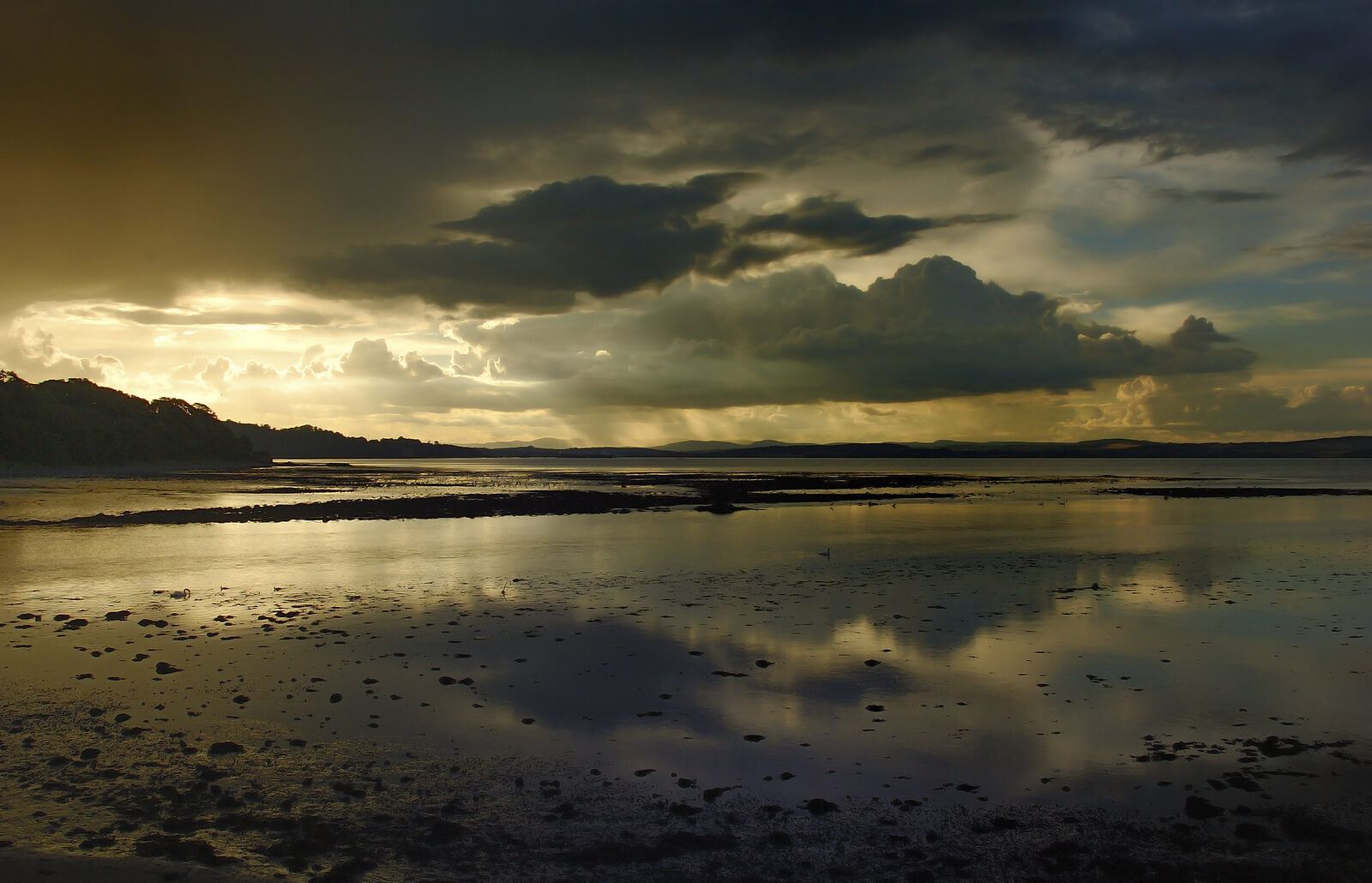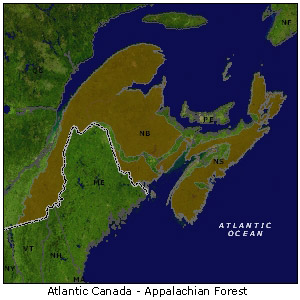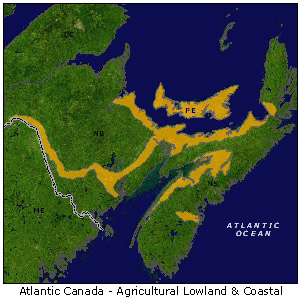Level IV Ducks Unlimited conservation priority area, supporting a diverse waterfowl community of more than 30 species

The Atlantic Canada region contains a wide diversity of habitats, waterfowl and wildlife communities. Major river systems, such as the St. Lawrence and St. John rivers, along with coastal habitats, play a crucial role for waterfowl populations in the Atlantic Flyway. Loss of wetlands or wetland functions began in the 1600s and has continued because of land use activities such as agricultural and urban expansion. Wetland losses have contributed to declines in waterfowl numbers. This prompted the development of landscape visions to provide a clear picture of the habitat base, as well as the waterfowl and wildlife benefits accruing from this habitat. The coastal and agricultural landscapes are intimately linked with waterfowl moving freely between landscapes often on a daily basis.


The Atlantic Region of Canada (Region 6*) includes 5 provinces (Quebec, New Brunswick, Nova Scotia, Prince Edward Island and Newfoundland – Labrador) with a total area of 2.3 million km2. It also includes 824,000 km2 of the Ontario sections of the Eastern Boreal Forest and Arctic, Taiga and James/Hudson Bay Lowland landscapes. The region contains a wide diversity of habitats, waterfowl and wildlife communities. Major river systems, such as the St. Lawrence and St. John Rivers, along with coastal habitats play a crucial role for waterfowl populations in the Atlantic Flyway.
Human populations have been established mainly on the coast and along major river systems. There are currently 9.6 million people in the region with relatively high population densities in the Maritimes (PEI 24/km2, NS 16.8/km2, and NB 10/km2). In Quebec, about 97% of the population live within the St. Lawrence River's watershed, with 69.5% of the population within 10 km of the river.
Loss of wetlands or wetland functions began in the 1600s and has continued because of land use activities such as agricultural and urban expansion. Wetland losses have contributed to declines in waterfowl numbers. This prompted the development of landscape visions to provide a clear picture of the habitat base as well as the waterfowl and wildlife benefits accruing from this habitat. A total of seven landscapes make up the Atlantic region, including 6 terrestrial ecozones and one coastal landscape. The coastal and agricultural landscapes are intimately linked with waterfowl moving freely between landscapes often on a daily basis.
The region supports a diverse waterfowl community of more than 30 species. There are important breeding, staging (spring and fall), molting and wintering habitats. The area supports significant waterfowl numbers (1.33 million breeding pairs, 2.12 million staging, 152,600 molting and 647,000 wintering birds). The region produces birds important to the Atlantic flyway such as American black ducks (black duck), green-winged teal, ringed-necked ducks, mergansers, goldeneyes, Canada and greater snow geese, scoters and eiders. The annual fall flight is estimated at 7.8 million birds.
Declines from historic levels have occurred for some species (black ducks, goldeneyes, eiders, scoters and the North Atlantic population of Canada geese) over the past decades. However, over the past 10 years, waterfowl populations are generally stable or increasing with the exception of goldeneye, mergansers and sea ducks. Most of the endangered eastern harlequin ducks are in this region. Some species such as mallards and wood ducks are increasing. There has also been a spectacular increase in greater snow goose numbers with spring estimates of 800,000 birds.
Strategic Planning for this diverse region of Canada has departed somewhat from the delineation of Bird Conservation Regions recognized for NABCI. DU staff in Canada felt it was more germane to their planning needs to recognize five distinct landscapes: Coastal, Forested, Agricultural Lowland, Maritime Appalachian Forest, Boreal Forest and Arctic, Taiga and James Bay Lowland. These generally apply to Bird Conservation Regions: 7 (Taiga Shield and Hudson Plains in Quebec and Labrador), 8 (Boreal Softwood Shield in Quebec, Labrador and Newfoundland), 12 (Boreal Hardwood Transition in Quebec), 13 (Lower Great Lakes/St Lawrence Plain in Quebec) and 14 (Atlantic Northern Forest in Nova Scotia, New Brunswick and Prince Edward Island).
*Region 6 - NABCI Bird Conservation Regions 7, 8, 12, 13 and 14 (in Canada ).
| Length of coastline | Atlantic region 31,800 km |
| Wetland area | Atlantic region 457,100 ha salt marsh, estuarine flats, saline ponds and islands |
| DU managed wetlands | Maritimes 1,466 ha, 5,700 eider nest shelters |
| Waterfowl numbers | Atlantic region 130,000 breeding pairs of eiders |
| Molting numbers | Labrador 62,000 scoters and 600 harlequins, NS 40,000 eiders, St. Lawrence: 50,000 scoter |
| Staging numbers | Atlantic Provinces 100,000 geese, 100,000 ducks, QC 220,000 ducks and geese, 200,000 scoter |
| Wintering numbers | Maritimes 167,000, NF and LAB 230,000, Quebec 200,000 |
| Other species | Millions of seabirds, 4.8 million shorebirds during fall migration |
| Waterfowl goals | Could support increased breeding and non-breeding populations |
The coastal landscape is a complex mix of salt marshes, estuaries, tidal mud flats, islands, saline ponds, rock and beach shoreline as well as offshore areas. Habitats depend on the varying tidal regimes and climatic conditions. Waterfowl use is mainly in the form of staging and wintering, although common eiders use coastal islands for nesting.
The vast majority of human settlement has occurred on the coasts of this region. Significant wetland loss has occurred with an estimated 65% of the salt marsh in the Bay of Fundy having been dyked with 27,300 ha remaining. In addition, 5,000 ha of salt marsh remain in the St. Lawrence estuary. Urban, recreational, and industrial developments have impacted coastal habitats to varying degrees, however, urban expansion continues to impact all coastal systems. Intensification and diversification of resource extraction (i.e. aqua-culture, inter-tidal harvest, marine traffic) is placing additional stress on the environment and increasing interactions between waterfowl and humans. Human activities result in considerable direct mortality of waterfowl and seabirds in this landscape with significant losses being attributed to oiling, gill nets, and harvest. Depredation of ducklings by great black-backed gulls is also a significant source of mortality.
The coastal landscape supports a diverse waterfowl community including dabbling, diving and sea ducks as well as geese. Waterfowl use this area throughout the year, with significant numbers of staging, breeding and wintering waterfowl. This landscape supports the majority of breeding common eiders. In addition, as a significant proportion of the continental scoter and eider population stage, molt and winter in this area. There are also millions of seabirds that use this area throughout the year. In addition, an estimated 4.8 million shorebirds migrate through the Atlantic Provinces every fall and rely on the coastal habitat during their stay.
The coastal landscape is the keystone habitat in Atlantic Canada. Sufficient coastal habitat exists to support current waterfowl populations, although habitat loss continues and threats are increasing. Complex interrelationships occur among the various coastal habitats and adjacent uplands that make some coastal regions more important to waterfowl than others. There will be an increased demand for property adjacent to the coast. Current legislation does not fully protect these habitats.
| Landscape area | Atlantic region 64,572 km 2 , Maritimes 20,000 km 2 (9,000 in small wood lots), Quebec 44,572 km 2 |
| Proportion of land base | Atlantic Region 3%, Maritimes 15%, Quebec 2.6% |
| Wetland area | Atlantic region 491,700 ha, Maritimes 46,000 ha (mean 2.3 ha/km 2 , range 0.3 – 8.8), Quebec 445,700 ha (mean 10 ha/km 2 , range 5-24) |
| DU-managed wetlands | Atlantic region 30,000 ha, Maritimes 14,000 ha, Quebec 16,000 ha |
| Breeding pairs of waterfowl | Atlantic region 201,600, Maritimes 10,000, Quebec 191,600 |
| Staging waterfowl | Atlantic region 1,500,000, Maritimes 150,000 ducks and 100,000 geese, Quebec 250,000 ducks and 1,000,000 geese |
| Wintering waterfowl | St. Lawrence 50,000 ducks and geese |
| Waterfowl goals | Maritimes 20,000 breeding pairs, Quebec 256,000 breeding pairs and 1.5 million staging birds. |
The agricultural landscape ranges from intensive corn and grain cultivation to a mosaic of farmed land, small woodlots, rough cover and urban development. Major rivers and the surrounding valley (i.e. St. Lawrence River and estuary and St. John River), Bay of Fundy dyked land, and the Northumberland Plain are included in the landscape. In Quebec, agriculture continues to intensify with 26% of the land base being farmed. However, in some areas up to 60% of the land is farmed. Corn, cereal, dairy, and beef make up most of the active farm practices. In the Maritimes, agricultural activity peaked in the early 1900s when 30% of the total Maritime land base was actively farmed. Today, farming occurs on 15% of the land base, but at greater intensity. Potato, dairy, beef, hogs, sheep as well as vegetables and fruit make up most of the active farming practices. More than 70% of the Atlantic population lives in this area. Consequently the land is primarily privately owned. Urban expansion is steadily increasing and changing this landscape.
Wetland loss in this landscape is difficult to determine since most of the loss occurred prior to aerial photography. In addition, there are no wetland inventories in Quebec. We do know that wetland loss did occur on a fairly large scale in some regions. Upgrading and maintenance of land drainage continues to reduce the extent of wetland areas. In the Maritimes, DU has played a key role by conserving 30% of the wetlands in the landscape through restoration and enhancement. DU's program has focused on the best quality-breeding habitat. Beaver ponds are important habitats but have fluctuated greatly in numbers over time. Wetland loss continues through small-scale drainage and in filling. Slower and less obvious actions such as sedimentation and eutrophication decrease the functional value of wetlands to waterfowl, other wildlife and people.
Agricultural lands support a rich diversity of waterfowl species during both the breeding and staging period. The productive wetlands in this landscape result in the greatest breeding densities of all the landscapes in Atlantic Canada. Waterfowl estimates however, are limited by the lack of good survey information and population estimates are likely conservative. While loss of wetlands has resulted in a reduction of the waterfowl carrying capacity for breeding birds, the availability of nutrient rich food, both in the form of waste grain, and green forage has greatly improved the value of this landscape for staging waterfowl. DU has been successful in securing and managing many of the highest quality wetlands in this landscape.
The vision that DU has set for this landscape is to protect the existing habitat base and increase waterfowl numbers through habitat protection and restoration.
| Landscape size | Atlantic region 204,625 km 2 , Maritimes 110,500 km 2 , Quebec 94,125 km 2 |
| Proportion of the land base | Atlantic region 9%, Maritimes 85%, Quebec 6% |
| Wetland area | Atlantic region 538,000 ha, Maritimes 350,000 ha, Quebec 188,000 ha |
| DU-managed wetlands | Atlantic region 13,500 ha, Maritimes 11,500 ha, Quebec 2,000 ha |
| Breeding pairs of waterfowl | Atlantic region > 50,000, Maritimes 50,000, Quebec No Data. |
| Waterfowl goals | 50,000 breeding pairs in the Maritimes |
The Appalachian forest is the transition zone between the southern deciduous forest zone and the boreal coniferous region found further north. It contains mixed hardwoods and softwoods and is generally divided into highland and lowland regions. Sustainable or below sustainable levels of forest harvest is occurring in this landscape. Most of the land is privately owned (PEI 90%, NS 70%, NB 50% and QC 95%). Silvicultural activities are increasing to bolster long-term wood supplies. However, reduced wood supplies will push companies to harvest areas that are currently not economically feasible.
The wetlands in this region are generally nutrient poor, with many bogs. However, there are areas of quality wetlands. In the Maritimes, DU currently manages the majority of the productive wetlands in this landscape. Waterfowl breeding densities are typically low yet the landscape produces a significant number of waterfowl because of its size. Black ducks, green-winged teal, ring-necked ducks, goldeneyes and mergansers are the most common ducks. Significant beaver populations are maintaining a large number of ponds in this landscape.
| Landscape size | Atlantic region 715,446 km 2 , NF 107,120 km 2 , Quebec 608,326 km 2 , Ontario 560,000 km 2 |
| Proportion of total land base | Atlantic Region 32%, NF and Lab 29%, Quebec 36%, Ontario 57% |
| Wetland area | Atlantic region 3,086,000 ha, NF 686,500 ha, Quebec 2,400,000 ha |
| DU-managed wetlands | Atlantic region 6,071 ha, NF 1,071 ha, Quebec 5,000 ha, Ontario 32,239 ha |
| Breeding pairs of waterfowl | Atlantic region 277,850, NF 32,100 ducks, 15,750 Canada geese, Quebec 230,000 ducks and geese, Ontario 450,000 |
| Waterfowl goals | 727,850 breeding pairs |
The boreal forest zone encompasses 32% of the Atlantic Canada Region and more then 57% of Ontario. The boreal is basically a coniferous forest with some hardwood mix in southern latitudes. Half the boreal forest in NF is considered unproductive forest, which means it, cannot be sustainably harvested. Intensive forest harvesting is occurring close to NF pulp mills and expansion into Labrador is a real possibility. Ninety-nine percent of the forests in NF are Crown owned. Commercial forests cover 46% of Quebec and are Crown owned. In Ontario, over 90% of the land is Crown owned and 75% is considered productive commercial forest.
Wetlands are numerous, generally low in productivity, with more productive "pockets" occurring. Waterfowl are dispersed at low densities, yet the large land mass results in a significant proportions of the total Atlantic region's black duck, green-winged teal, goldeneye, scoter and Canada goose production coming from the boreal forest. Beaver populations have recovered from low levels in the 1940s and have created innumerable ponds. In Ontario, the vast size of the boreal forest results in a fall flight of more then 3.5 million waterfowl.
Forestry, hydroelectric development and acid rain have the most significant impact on this landscape. Forestry remains the primary land use. Current projections are for a wood shortfall over the next 20 – 30 years. There has been a significant increase in silviculture; however, it remains unclear if this will offset the shortfall. This shortfall will force forestry operations in areas currently considered unprofitable, thereby increasing human access. The most significant influence of forestry is likely the development of the road system allowing access to previously remote areas.
| Landscape size | Atlantic region 1,329,795 km 2 , Ontario 264,000 km 2 |
| Proportion of the land base | Atlantic region 60%, Ontario 27% |
| Wetland area |
Atlantic region 22,796,900 ha, Arctic 2,070,000 ha, Taiga 18,300,000 ha, James Bay Lowlands 2,426,900 ha |
| Waterfowl breeding pairs | Atlantic region 674,350, Lab 65,200 ducks, 29,150 Canada geese, Quebec 580,000 ducks and geese, Ontario 657,000 |
| Waterfowl goals | 1,331,350 breeding pairs |
This landscape encompasses 60% of the Atlantic region and includes tundra and lowland habitat as well as taiga that represent a transition zone between the boreal forest and tundra. In Ontario, this region represents 27% of the total land base, and contains the most extensive continuous wetland ecosystem in the world. There is limited human activity in this area. Wetlands are abundant but of limited productivity, with the exception of the relatively productive James Bay Lowlands. The land is owned either by the crown or aboriginal people.
Breeding waterfowl typically occur at low densities. However, significant areas of greater density occur adjacent to the coast and on the Ungava peninsula. Critical staging and breeding habitats occur within a 100 km band along the James and Hudson Bay. Common species include black ducks, Canada geese and scoters. Waterfowl production from this area makes a significant contribution to the Atlantic and Mississippi Flyways. Canada Geese of the Southern James Bay population have experienced significant population decline since the late 1980s. Breeding snow geese in the region have shown remarkable growth during the same period, resulting in concerns for breeding ground integrity and the future of the breeding populations. Low human activity results in little direct threat to wetlands or waterfowl. However, activities in this area are typically at a large scale and can potentially have significant consequences for waterfowl and wildlife. In addition, climate change may result in extreme long-term impacts.
Ducks Unlimited uses cookies to enhance your browsing experience, optimize site functionality, analyze traffic, and deliver personalized advertising through third parties. By continuing to use this site, you agree to our use of cookies. View Privacy Policy